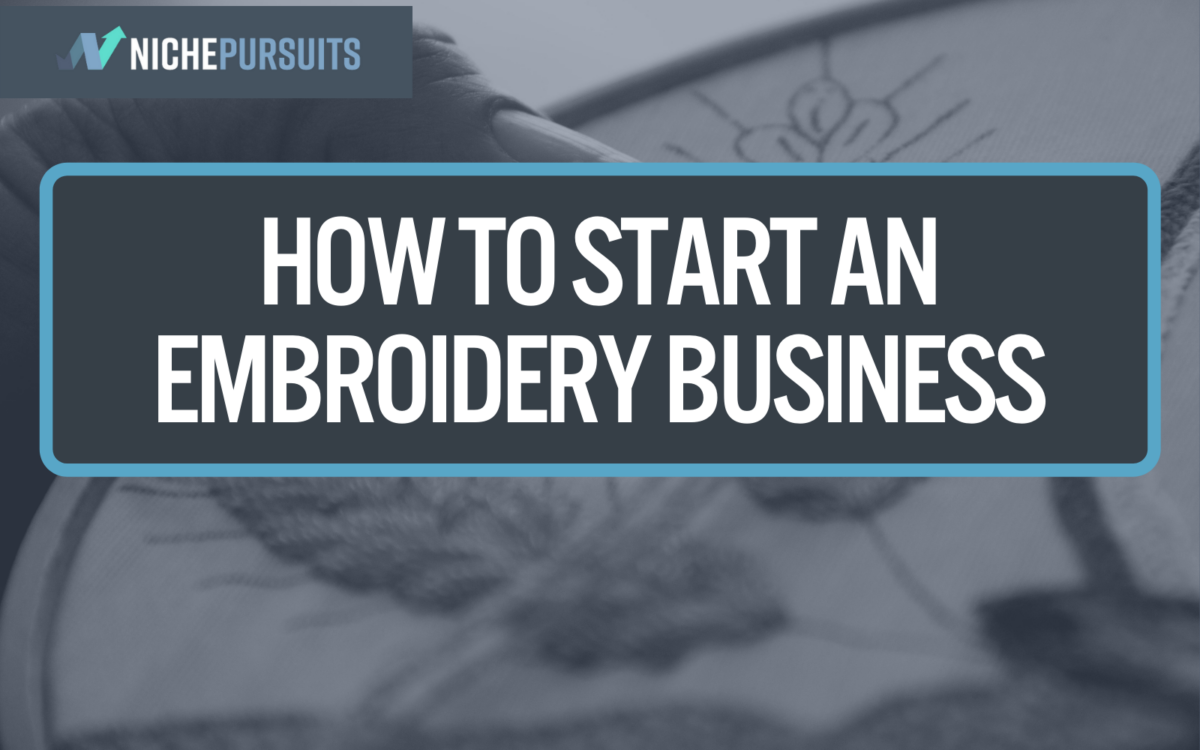How To Start An Embroidery Business In 17 Easy-To-Follow Steps

When you buy something through one of the links on our site, we may earn an affiliate commission.
When learning how to start an embroidery business, paying attention to the minor details is essential.
This embroidery industry can be highly profitable. However, mistakes can cost you significant sums early on and quickly put you out of business.
The following steps will help you more easily navigate the waters and avoid crippling mistakes many people with small business ideas make.
Contents
- What Does an Embroidery Business Do?
- Complete Guide On How To Start A Successful Embroidery Business
- 1. Investigate what type of embroidery services are in your area
- 2. Figure out your ideal potential customer
- 3. Create An Embroidery Business Plan
- 4. Differentiate Yourself from Your Competitors
- 5. Brainstorm a Business Name
- 6. Choose your business structure
- 7. Register for Taxes
- 8. Apply for Licenses/Permits
- 9. Open a Business Bank Account
- 10. Get Insurance
- 11. Secure Funding
- 12. Find a Location
- 13. Buy Your Commercial Embroidery Equipment and Supplies
- 14. Set Your Embroidery Prices
- 15. Set Up Your Website and Begin Marketing
- 16. Make It As Easy as possible for people to pay you
- 17. Leverage Your Existing Relationships
- Tips for starting an embroidery business
- Things To Consider Before Starting an Embroidery Business
- Common Questions About Starting an Embroidery Business
- Final Thoughts on How To Start An Embroidery Business
What Does an Embroidery Business Do?
Embroidery is the art of decorating materials such as fabric and custom apparel using yarn, thread, or similar materials with an embroidery machine.
Everyday items people bring in for embroidery include jackets, polo shirts, hats, towels, bathrobes, and more.
Some of the most common customers for embroidery shop owners include businesses, government agencies, and schools. Usually, these orders are for polo shirts or other professional wear with logos and employee names.
Many embroidery companies are small businesses with only one or two employees. However, it is possible to build a larger embroidery business with enough customers.
Complete Guide On How To Start A Successful Embroidery Business
While not necessarily in exact order for all circumstances, the steps below will provide a good primer when learning how to start an embroidery business.
1. Investigate what type of embroidery services are in your area
The first thing you need to do when starting an embroidery business (or any kind of business) is to conduct market research to see if there is a demand for your product or service.
You need to understand your market to ensure there is room in it for your business and not too many competitors.
It doesn't mean you should give up if there are already a couple of other embroidery businesses nearby. It's a good indication if there is already some existing competition because it means there is at minimum enough demand to support more than one business.
You want to avoid having too many businesses and not having enough demand. Try to learn what the local market for your product/service is like and whether there is an underserved market.
You should ideally speak to businesses or individuals who use embroidery services regularly to see if they have problems that your new embroidered goods business can solve.
2. Figure out your ideal potential customer
Before you start a new custom embroidering business, you need to know if it's sustainable in your area. You need to develop what's called “buyer personas.”
They're fictional representations of your target buyers that will help you get a better idea of how you can start an embroidery company.
HubSpot provides an excellent guide on creating buyer personas. The idea is to have a single person who targets everything from your branding to your marketing around what he or she likes.
Research as much as possible on your target buyer. Don't just look for things online; go out there and talk to people, too. Approach potential businesses and find out who makes purchasing decisions for them. Interview them to see if they're looking for something specific.
The more information you know about your target customer, the more likely you'll be able to create a product they want to buy.
The difference between successful businesses and failed businesses is often the extent to which they plan. Don't take shortcuts here.
3. Create An Embroidery Business Plan
When you've completed the industry analysis and have a detailed and targeted buyer persona, it's now time to create a business strategy.
A business plan will tell you everything from how to get started to how to grow your business. When you need help, you will always turn to your business plan as your guide.
Many templates and how-to articles are available for people to write their business plans. However, I've always used liveplan.com. This tool helps you create a business plan by walking you through the process step-by-step.
Check out LivePlan to help get your business plan off the ground.
Check Out LivePlanOne advantage here is the bundled deal with QuickBooks, which you will need for accounting. Take your time when creating your business plan. It's not something you need to rush.
Writing a good business plan can help you get through the tough times by ensuring you don't waver from your intended goals.
4. Differentiate Yourself from Your Competitors
This is the final stage of the research phase when first starting an embroidery business Think about your unique value proposition and how it will appeal to your target buyer.
Your unique value proposition is the single most important thing that sets you apart from your competitors. It goes way beyond simple things like better service or faster service. It includes things like better product design, better marketing, better sales, etc.
To create a compelling unique value proposition (UVP), you need to think of an idea that for your competitors to copy, they'd have to restructure their whole business operation. Domino Pizza's original UVP, “Hot in 30 minutes or your money back,” is an excellent case study of this.
To compete, other pizza companies would have to completely redesign their systems and training. It would be a monumental task that would require too much time and money.
First, look at the competition to determine what they offer that's different and unique and what they lack. Think about your target customer personas and what would motivate them to switch to your embroidering business.
You won't know for sure until you take a look at your competitors' offerings and your own. However, don't cut corners when trying to find a unique value proposition. Companies have been known both to fail and succeed on the basis of this single factor.
5. Brainstorm a Business Name
It may seem counterintuitive to wait until the very end to choose a business name. However, it can save you time, money, and stress when starting an embroidery business for the first time.
Many people rush to get their business started by creating a business name, buying domain names, registering business structures, and creating business cards. The problem is that your initial ideas might not be related to your final business once you have done all of the above research.
Waiting until after you conduct market research and create a business plan lets you choose a name that is in sync with your research (and we put together a guide on how to name your business to help). You might be able to include your unique value proposition if it makes sense.
When thinking of a good business idea, here are some things to keep in mind:
- It needs to be easy to speak and remember
- Make sure social profiles are available
- Ensure you can get the domain name (check out how to choose a domain name)
- It should accurately reflect your business now and in the future
Make sure that you choose a name that you can work with as you grow your embroidery business. For more embroidery business name ideas, see our complete guide for inspiration. You will also need a catchy tagline. Take a look at our list of awesome embroidery business slogans.
6. Choose your business structure
Another important step when starting an embroidery business involves setting up a legal structure suitable to your business.
While you may be inclined to use one of the online cheap lawyer services, don't skimp on quality. Find a reputable business lawyer in your area and consult him/her about the best structure for your company at the time.
A business structure will protect you from any legal issues arising from someone suing you or you needing to file for bankruptcy. It will separate your business and personal assets, ensuring you don’t lose your vehicle, home, or personal savings if something happens to you.
You want to set up your business before you start doing anything else, and you want all your banking accounts under one structure.
7. Register for Taxes
Before starting your business, you must first register for taxes. If you followed the advice above, this will likely already have been taken care of by your attorney when filing your business with the state.
Set up a calendar with tax payment dates so you don't forget. Sales taxes vary by state, but they're usually handled quarterly.
If you fail to submit by the required date, you risk having all of your business checking and savings accounts frozen. You would then need to pay out of your personal money to recover accounts. So be sure to file and pay.
You may want to talk to an accountant to get a better understanding of what tax liabilities you will face.
Whatever you do, be sure to pay your taxes on time each year and in the right amount to avoid disruptions to business or penalties.
8. Apply for Licenses/Permits
This is another step your attorney will likely handle for you when setting up the business.
Each city and state varies, so make sure you know what permits or licenses you must obtain before starting your business. If they weren't handled during the business formation, take care of that now!
Most state governments and municipalities will have a dedicated office handling permits and licensing. You can call up this office to get the information you need for your specific business.
9. Open a Business Bank Account
To open a business banking account, you are required to have a properly set up business entity. Make sure you've completed the previous steps before getting to this step.
You ideally want two accounts, one to receive incoming payments and another for expenses and outgoing payments. This will make accounting for your business much easier when it comes to reconciling all of your expenses in either Quickbooks, Xero, or similar accounting software
Another tip is to avoid big financial institutions when starting out. Larger banks such as Chase or Wells Fargo often charge ongoing fees. If you can, try a local credit union.
Large banks can be good options if you're looking to expand into multiple locations or if you're working with international clients and vendors. However, when starting out, fees from larger banks will eat into the profits.
10. Get Insurance
Make sure you check into what insurance you will require as an embroidery shop owner. Some of the most common insurance types include:
- General Liability Insurance
- Property Insurance
- Auto Insurance (for company vehicles)
- Crime Insurance
There are many events, including employee injuries, property losses, or customer property damages, that could permanently cripple your business.
Some of these insurance policies, such as general liability coverage, may be legally required for your business. Look into the local city and state regulations to ensure you are compliant.
11. Secure Funding
You need capital to get started and keep going. Ideally, you will have enough initial capital to sustain yourself for at least one full year while you work to earn a profit.
There are various ways you can secure funding, from crowdfunding to bank loans. Some other ways include:
- Investors
- Family and Friends
- Savings (owners' capital)
- Grants
Many cities and states provide grants for new small businesses that can help you save substantial amounts. Examples include facade grants for building improvements in certain city areas, or grants specific to minority or disadvantaged business owners.
Check out the website for city and state organizations overseeing economic development. Also, take a look at the Small Business Association (SBA) for grants and loans applicable to your circumstances.
12. Find a Location

After securing funding, the next step in starting an embroidery business would be to find a location to set up shop.
If you're in an area where you can't afford to rent office space, you might be able to work from home initially. However, many cities do not allow this, so find out beforehand.
Remember that many cities provide grants for building renovations in old parts of town. You may be able to save some money by doing this, so consider looking into these options before making a final decision on a location.
13. Buy Your Commercial Embroidery Equipment and Supplies
Once you've settled into a location, it's time to get everything you need to run your business.
For an embroidery business, this will include equipment such as:
- Commercial embroidery machine
- Yarn, thread, and other raw materials
- Computers and embroidery software
- Shirts, hats, other embroidered goods
You will likely also need different kinds of needles, office equipment, and so on. Make a list of every single thing you absolutely need when starting out. Next, make a secondary list containing items that you'll need but aren't required immediately.
Start by procuring everything from your essentials list. Then, as you begin to turn a profit, move onto the secondary list.
14. Set Your Embroidery Prices
Set your prices after you've acquired everything and have an idea for your expenses such as rent and utilities.
Make sure you've considered all of your fixed and variable costs. One of the most common mistakes new business owners make when starting out is forgetting expenses which can easily eat up their profits.
You don't want to go broke because you didn't track and account for expenses properly.
Here is an article by Inc Magazine explaining why pricing products and services matters. Don't rush into things. Make sure you can turn a good profit.
15. Set Up Your Website and Begin Marketing
You should also consider online marketing expenses. Once upon a time, having a website was a luxury. Nowadays, it's an absolute necessity.
Consider taking one of these top online marketing courses to build up a solid foundation of marketing knowledge.
There are many platforms you can use to create a business website. These include:
- WordPress
- GoDaddy
- Squarespace
- Wix
As the owner of a marketing agency, however, I would recommend working closely with a professional.
You need to decide whether you want to be an embroidery business owner or a full-time marketer for an embroidery company.
It may seem expensive, but ROI for online marketing is usually between 5:1 and 10:1, with some great results reaching even higher than that. That means you earn $5-$10 per dollar you spend.
If you decide to create a business site yourself, consider using GoDaddy.
Check Out GoDaddy Here16. Make It As Easy as possible for people to pay you
You're almost done. Most people, especially small business owners, will pay you electronically, so make sure you know how to accept payments.
You will need to set up an online payment system. This can be done by using a processor such as:
- Square
- PayPal
- Local processors
Each of these will charge fees for handling payments, which means you'll need to consider the costs and then include them in your pricing model.
17. Leverage Your Existing Relationships
It's now time to start thinking about how you can get your first customers.
If you followed my suggestions and contacted a marketing agency for help, great. It may take several months before you see any results from that.
At first, the best way to gain clients will be through people who already know and who trust you. Consider everyone you know and whether any of them may need your services. Also, think about people they may know who they can connect you with.
You should also consider joining networking groups like your chamber of commerce or networking clubs like BNI. They're a great way to build up your network, ensuring consistent clients for the long run.
Tips for starting an embroidery business
If you follow the above steps, you should do fine. Here are some additional tips to help you learn to start an embroidering business.
Don't Take on Too Many Projects
At first, it may seem tempting to take on as many projects as possible. However, it's important to deliver on time.
Make sure you're not taking on any work that you cannot realistically deliver on by the agreed date. As you grow, hire other people when you can afford to.
If you're growing faster than you can handle, consider outsourcing or negotiating a deal with another embroidery shop. You will have to give up a share of the profits, however, you will be able to retain customers while you grow and can service them yourself later on when you have the capacity.
Don't Try to Do Everything Yourself
Continuing off the above tip, don't be afraid to hire employees when you have the money and enough customers. There comes the point when you can no longer take on more work yourself without quality suffering, hurting your reputation.
As you grow, be aware of your growth and plan for the future by setting money aside to hire employees. This can free up some of your time to work on generating leads.
Brand Yourself

As mentioned before, take the time to get to know your audience and brand yourself appropriately. Don't try to learn everything by yourself; instead, get help from people who know what they're doing.
For new business owners, branding work has become cheaper thanks to online design resources like 99Designs. Make sure you get it right the first go-round, and you can reap all the benefits of looking more organized and polished.
Find a Branding Designer on 99designsThings To Consider Before Starting an Embroidery Business
These steps will help you improve your chances of success, but you should also understand the potential drawbacks to the embroidering business.
Competition Intensity Is High
Newer and easier-to-use technology has significantly lowered the barriers to entry for people who would like to start their own embroidery business.
It has led to more people entering the industry and increased competition. It doesn't mean that you shouldn't start, but it does mean that it will be more difficult than before.
Low To No Switching Cost For Customers
Switching costs refer specifically to the expenses incurred by companies or individuals when they switch from one product or service provider to another.
An example of this is moving to a new apartment. Even if money isn't an issue, the time lost organizing things ensures you'll probably stay where you are for a long time.
Embroidery firms don't enjoy the same switching costs like many other industries. It's easy for clients to switch to another embroidery service provider. So, you may have a higher churn rate.
Common Questions About Starting an Embroidery Business
To help you in learning how to start an embroidery business, here are answers to some of the most common questions on the subject.
How much does it cost to start an embroidery business?
The cost to start an embroidery business can vary significantly, with the average shop spending around $11,000.
You could spend a few thousand dollars for home-based businesses or between $10k – $20k to open a large and well-equipped embroidery shop with a computerized embroidery machine.
How much can you earn from an embroidery business?
Embroidery business owners can earn high five figures to low six figures each month and higher. How much you make will be a product of how efficient you are and how fast you can scale.
It's essential you are pricing services and products accordingly. Make sure your margins are reasonable and don't wait to get on top of marketing or hire an agency.
What can I embroider to sell?
There are many embroidered items you can sell to individuals and companies, including:
- Polo Shirts
- Bath Robes
- Towels
- Medical Scrubs and Coats
- Golf Bags
The list goes on. It's most likely that the bulk of your orders will come from shirts for businesses and events.
Final Thoughts on How To Start An Embroidery Business
For new business owners interested in learning how to start an embroidery business, know that no matter what, the keys to success are consistency and reliability.
It's essential to follow the steps above, but they need to be matched with solid business practices. The more consistently you can deliver a high-quality product on time, the more work you will bring in.
Lastly, don't skimp on marketing and building relationships. Sales and marketing are most of what any business is about. So, look at it as an investment and make sure you plan properly to grow your business.
And if you decide to start an embroidery business, check out our guide on how to get free advertising online for your business!
Want to learn step-by-step how I built my Niche Site Empire up to a full-time income?
Yes! I Love to Learn
Learn How I Built My Niche Site Empire to a Full-time Income
- How to Pick the Right Keywords at the START, and avoid the losers
- How to Scale and Outsource 90% of the Work, Allowing Your Empire to GROW Without You
- How to Build a Site That Gets REAL TRAFFIC FROM GOOGLE (every. single. day.)
- Subscribe to the Niche Pursuits Newsletter delivered with value 3X per week
My top recommendations
















